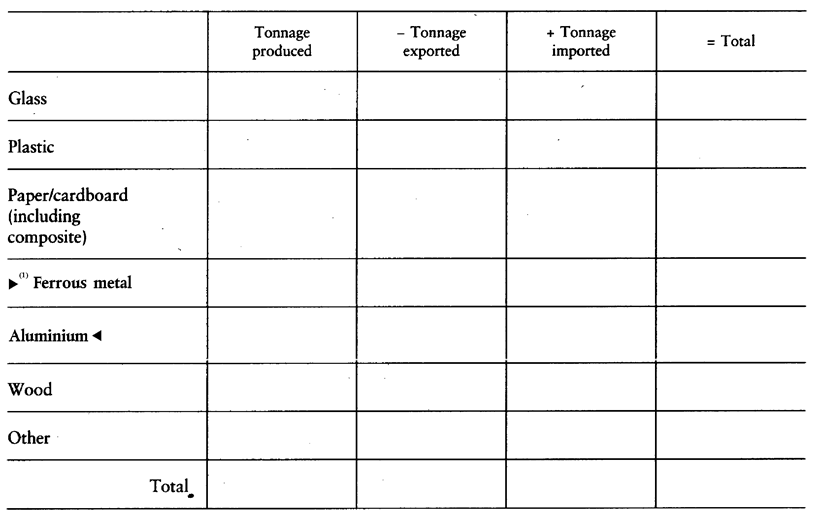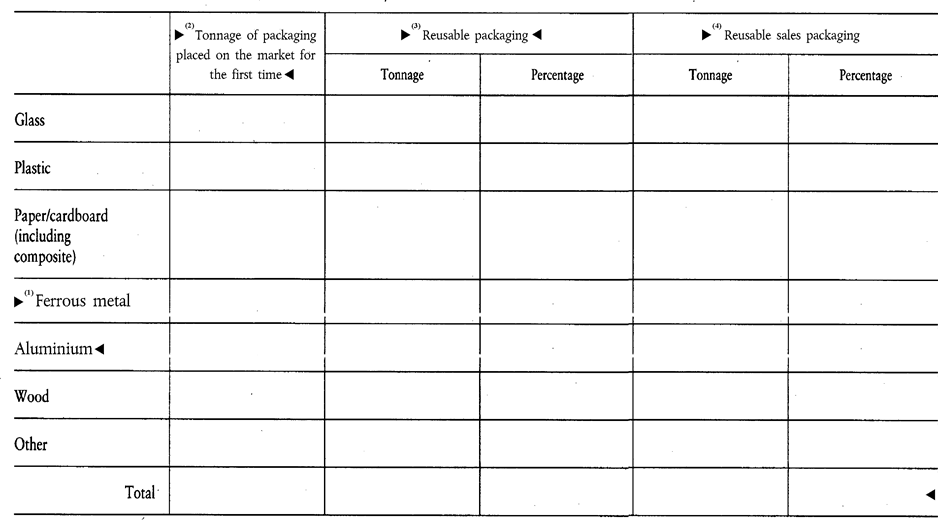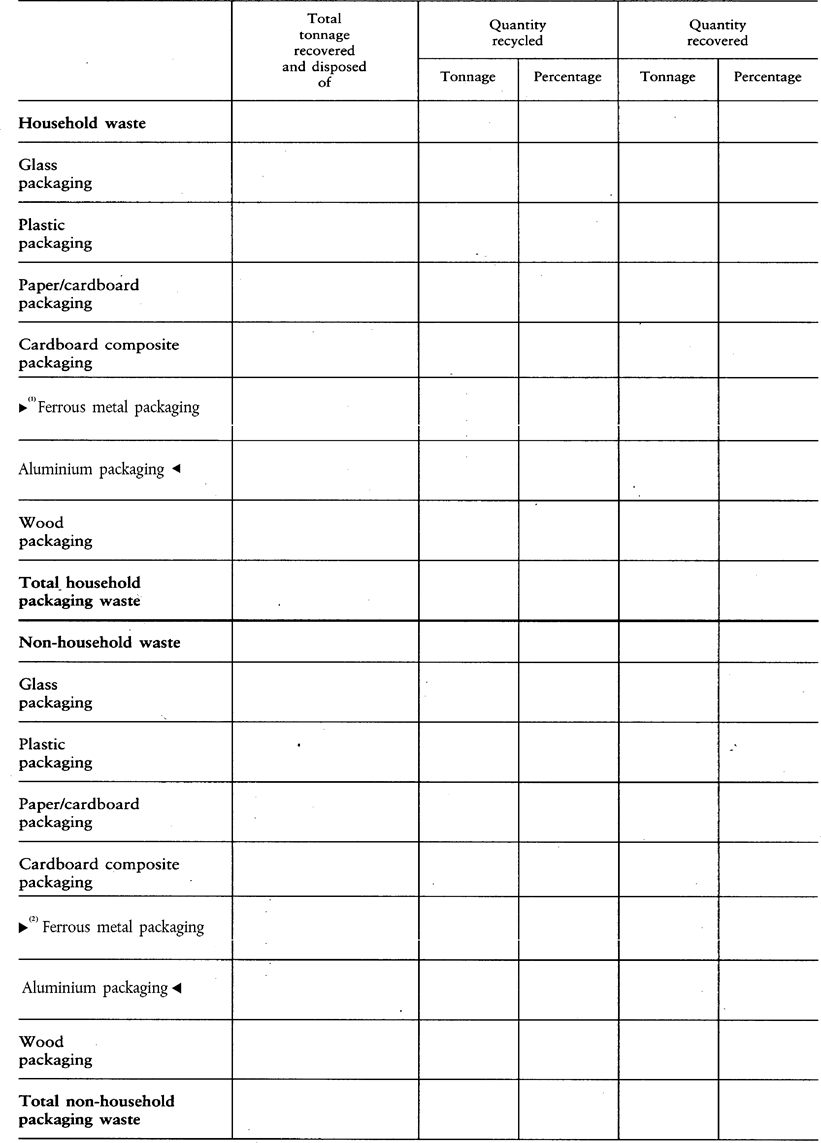- Latest available (Revised)
- Point in Time (04/07/2018)
- Original (As adopted by EU)
European Parliament and Council Directive 94/62/ECShow full title
European Parliament and Council Directive 94/62/EC of 20 December 1994 on packaging and packaging waste
You are here:
- Directives originating from the EU
- 1994 No. 62
- Annexes only
- Show Geographical Extent(e.g. England, Wales, Scotland and Northern Ireland)
- Show Timeline of Changes
More Resources
Revised version PDFs
- Revised 04/07/20180.70 MB
- Revised 26/05/20150.30 MB
- Revised 28/02/20130.29 MB
- Revised 20/04/20090.15 MB
- Revised 05/04/20050.14 MB
- Revised 18/02/20040.13 MB
- Revised 20/11/20030.12 MB
When the UK left the EU, legislation.gov.uk published EU legislation that had been published by the EU up to IP completion day (31 December 2020 11.00 p.m.). On legislation.gov.uk, these items of legislation are kept up-to-date with any amendments made by the UK since then.
This item of legislation originated from the EU
Legislation.gov.uk publishes the UK version. EUR-Lex publishes the EU version. The EU Exit Web Archive holds a snapshot of EUR-Lex’s version from IP completion day (31 December 2020 11.00 p.m.).
Changes over time for: European Parliament and Council Directive 94/62/EC (Annexes only)
Status:
EU Directives are published on this site to aid cross referencing from UK legislation. Since IP completion day (31 December 2020 11.00 p.m.) no amendments have been applied to this version.
[F1ANNEX I U.K. ILLUSTRATIVE EXAMPLES FOR THE CRITERIA REFERRED TO IN ARTICLE 3(1)
Textual Amendments
Illustrative examples for criterion (i) U.K.
Packaging U.K.
Sweet boxes
Film overwrap around a CD case
Mailing pouches for catalogues and magazines (with a magazine inside)
Cake doilies sold with a cake
Rolls, tubes and cylinders around which flexible material (e.g. plastic film, aluminium, paper) is wound, except rolls, tubes and cylinders intended as parts of production machinery and not used to present a product as a sales unit
Flower pots intended to be used only for the selling and transporting of plants and not intended to stay with the plant throughout its life time
Glass bottles for injection solutions
CD spindles (sold with CDs, not intended to be used as storage)
Clothes hangers (sold with a clothing item)
Matchboxes
Sterile barrier systems (pouches, trays and materials necessary to preserve the sterility of the product)
Beverage system capsules (e.g. coffee, cacao, milk) which are left empty after use
Refillable steel cylinders used for various kinds of gas, excluding fire extinguishers
Non-packaging U.K.
Flower pots intended to stay with the plant throughout its life time
Tool boxes
Tea bags
Wax layers around cheese
Sausage skins
Clothes hangers (sold separately)
Beverage system coffee capsules, coffee foil pouches, and filter paper coffee pods disposed together with the used coffee product
Cartridges for printers
CD, DVD and video cases (sold together with a CD, DVD or video inside)
CD spindles (sold empty, intended to be used as storage)
Soluble bags for detergents
Grave side lights (containers for candles)
Mechanical quern (integrated in a refillable recipient, e.g. refillable pepper mill)
Illustrative examples for criterion (ii) U.K.
Packaging, if designed and intended to be filled at the point of sale U.K.
Paper or plastic carrier bags
Disposable plates and cups
Cling film
Sandwich bags
Aluminium foil
Plastic foil for cleaned clothes in laundries
Non-packaging U.K.
Stirrer
Disposable cutlery
Wrapping paper (sold separately)
Paper baking cases (sold empty)
Cake doilies sold without a cake
Illustrative examples for criterion (iii) U.K.
Packaging U.K.
Labels hung directly on or attached to a product
Part of packaging U.K.
Mascara brush which forms part of the container closure
Sticky labels attached to another packaging item
Staples
Plastic sleeves
Device for measuring dosage which forms part of the container closure for detergents
Mechanical quern (integrated in a non-refillable recipient, filled with a product, e.g. pepper mill filled with pepper)
Non-packaging U.K.
Radio frequency identification (RFID) tags]
ANNEX IIU.K.ESSENTAIL REQUIREMENTS ON THE COMPOSITION AND THE REUSABLE AND RECOVERABLE, INCLUDING RECYCLABLE, NATURE OF PACKAGING
1.Requirements specific to the manufacturing and composition of packagingU.K.
Packaging shall be so manufactured that the packaging volume and weight be limited to the minimum adequate amount to maintain the necessary level of safety, hygiene and acceptance for the packed product and for the consumer.
[F2Packaging shall be designed, produced and commercialised in such a way as to permit its reuse or recovery, including recycling, in line with the waste hierarchy, and to minimise its impact on the environment when packaging waste or residues from packaging waste management operations are disposed of.]
Packaging shall be so manufactured that the presence of noxious and other hazardous substances and materials as constituents of the packaging material or of any of the packaging components is minimized with regard to their presence in emissions, ash or leachate when packaging or residues from management operations or packaging waste are incinerated or landfilled.
Textual Amendments
2.Requirements specific to the reusable nature of packagingU.K.
The following requirements must be simultaneously satisfied:
the physical properties and characteristics of the packaging shall enable a number of trips or rotations in normally predictable conditions of use,
possiblity of processing the used packaging in order to meet health and safety requirements for the workforce,
fulfil the requirements specific to recoverable packaging when the packaging is no longer reused and thus becomes waste.
3.Requirements specific to the recoverable nature of packagingU.K.
(a)Packaging recoverable in the form of material recyclingU.K.
Packaging must be manufactured in such a way as to enable the recycling of a certain percentage by weight of the materials used into the manufacture of marketable products, in compliance with current standards in the Community. The establishment of this percentage may vary, depending on the type of material of which the packaging is composed.
(b)Packaging recoverable in the form of energy recoveryU.K.
Packaging waste processed for the purpose of energy recovery shall have a minimum inferior calorific value to allow optimization of energy recovery.
[F2(c) Packaging recoverable in the form of composting U.K.
Packaging waste processed for the purpose of composting shall be of such a biodegradable nature that it does not hinder the separate collection and the composting process or activity into which it is introduced.
(d) Biodegradable packaging U.K.
Biodegradable packaging waste shall be of such a nature that it is capable of undergoing physical, chemical, thermal or biological decomposition such that most of the finished compost ultimately decomposes into carbon dioxide, biomass and water. Oxo-degradable plastic packaging shall not be considered as biodegradable.]
ANNEX IIIU.K.DATA TO BE INCLUDED BY MEMBER STATES IN THEIR DATABASES ON PACKAGING AND PACKAGING WASTE (IN ACCORDANCE WITH TABLES 1 TO 4)
1.For primary, secondary and tertiary packaging:U.K.
quantities, for each broad category of material, of packaging consumed within the country (produced + imported - exported) (Table 1);
quantities reused (Table 2).
2.For household and non-household packaging waste:U.K.
quantities for each broad category of material, recovered and disposed of within the country (produced + imported - exported) (Table 3);
quantities recycled and quantities recovered for each broad category of material (Table 4).
TABLE 1 Quantity of packaging (primary, secondary and tertiary) consumed within the national territory U.K.
TABLE 2 Quantity of packaging (primary, secondary and tertiary) reused within the national territory U.K.
TABLE 3 Quantity of packaging waste recovered and disposed of within the national territory U.K.
TABLE 4 Quantity of packaging waste recycled or recovered within the national territory U.K.
[F3ANNEX IV U.K. IMPLEMENTATION PLAN TO BE SUBMITTED PURSUANT TO POINT (D) OF ARTICLE 6(1A)
Textual Amendments
The implementation plan to be submitted pursuant to point (d) of Article 6(1a) shall contain the following:
assessment of the past, current and projected rates of recycling, landfilling and other treatment of packaging waste and the streams of which it is composed;
assessment of the implementation of waste management plans and waste prevention programmes in place pursuant to Articles 28 and 29 of Directive 2008/98/EC;
reasons for which the Member State considers that it might not be able to attain the relevant target laid down in points (g) and (i) of Article 6(1) within the deadline set therein and an assessment of the time extension necessary to meet that target;
measures necessary to attain the targets set out in points (g) and (i) of Article 6(1) of this Directive that are applicable to the Member State during the time extension, including appropriate economic instruments and other measures to provide incentives for the application of the waste hierarchy as set out in Article 4(1) of, and Annex IVa to, Directive 2008/98/EC;
a timetable for the implementation of the measures identified in point 4, determination of the body competent for their implementation and an assessment of their individual contribution to attaining the targets applicable in the event of a time extension;
information on funding for waste management in line with the polluter-pays principle;
measures to improve data quality, as appropriate, with a view to better planning and monitoring performance in waste management.]
Options/Help
Print Options
PrintThe Whole Directive
PrintThe Annexes only
Legislation is available in different versions:
Latest Available (revised):The latest available updated version of the legislation incorporating changes made by subsequent legislation and applied by our editorial team. Changes we have not yet applied to the text, can be found in the ‘Changes to Legislation’ area.
Original (As adopted by EU): The original version of the legislation as it stood when it was first adopted in the EU. No changes have been applied to the text.
Point in Time: This becomes available after navigating to view revised legislation as it stood at a certain point in time via Advanced Features > Show Timeline of Changes or via a point in time advanced search.
See additional information alongside the content
Geographical Extent: Indicates the geographical area that this provision applies to. For further information see ‘Frequently Asked Questions’.
Show Timeline of Changes: See how this legislation has or could change over time. Turning this feature on will show extra navigation options to go to these specific points in time. Return to the latest available version by using the controls above in the What Version box.
More Resources
Access essential accompanying documents and information for this legislation item from this tab. Dependent on the legislation item being viewed this may include:
- the original print PDF of the as adopted version that was used for the EU Official Journal
- lists of changes made by and/or affecting this legislation item
- all formats of all associated documents
- correction slips
- links to related legislation and further information resources
Timeline of Changes
This timeline shows the different versions taken from EUR-Lex before exit day and during the implementation period as well as any subsequent versions created after the implementation period as a result of changes made by UK legislation.
The dates for the EU versions are taken from the document dates on EUR-Lex and may not always coincide with when the changes came into force for the document.
For any versions created after the implementation period as a result of changes made by UK legislation the date will coincide with the earliest date on which the change (e.g an insertion, a repeal or a substitution) that was applied came into force. For further information see our guide to revised legislation on Understanding Legislation.
More Resources
Use this menu to access essential accompanying documents and information for this legislation item. Dependent on the legislation item being viewed this may include:
- the original print PDF of the as adopted version that was used for the print copy
- correction slips
Click 'View More' or select 'More Resources' tab for additional information including:
- lists of changes made by and/or affecting this legislation item
- confers power and blanket amendment details
- all formats of all associated documents
- links to related legislation and further information resources




